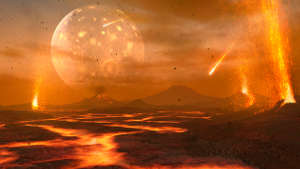Special Issue: Water Narratives
24 December 2025
Published online 17 May 2023
An Earth-sized planet found orbiting a red dwarf star likely experiences strong volcanic activity, but may also have hospitable regions.

MARK GARLICK/ SPL/ GETTY IMAGES
Now, an international team, led by Björn Benneke, at the University of Montréal, Canada, has observed an Earth-sized planet orbiting the M dwarf LP791-18, one of the smallest stars known to host planets. LP791-18 was already known to host a hot planet b, which orbits close to the star in less than a day, and a larger ‘sub-Neptune’ planet c that orbits in five days.
The new planet, LP791-18d (or planet d), is extremely close to Earth’s size and mass, but the similarities end there. It orbits between the other two planets in just 2.75 days and is tidally locked, meaning one side permanently faces the star, while the other is in permanent darkness.
Most interestingly, the gravitational pull of the large planet c prevents planet d from having a perfectly circular orbit. As a result, planet d gets squashed and stretched during its orbit, creating friction within the interior. This process, called tidal heating, probably causes strong volcanic activity on planet d’s surface.
“Planet d likely has an atmosphere of volcanic gases like CO2 and sulfur dioxide,” says Benneke. “Water may condense and freeze into a thick ice glacier on the permanent night side of the planet. But liquid water might exist near the terminator – the boundary between dayside and nightside – giving a region possibly like Iceland with ice, water and lots of volcanic activity.”
Benneke and co-workers first suspected the presence of planet d when they saw extra transit signatures in data from the infrared Spitzer Space Telescope, which observed LP791-18 for 127 hours. They then gathered and combined data from more than 10 different telescopes in space and on the ground until they had 72 transit observations.
Among the many scientists contributing to the study were two from the Middle East. Mohamad Ali-Dib at New York University Abu Dhabi was involved in modelling the tidal heating of the planet’s interior. Meanwhile, Zouhair Benkhaldoun at Cadi Ayyad University, provided ground-based observations from Oukaïmeden Observatory in the Atlas Mountains of Morocco, which helped in measuring the mass of planet d.
Benneke and co-workers look forward to learning more about the LP791-18 system using the powerful eyes of the James Webb Telescope. “The larger planet c will be observed this summer,” he says. “We hope to get observations of the exo-Earth LP791-18d as well next year.”
doi:10.1038/nmiddleeast.2023.54
Peterson, M.S. et al. A temperate Earth-sized planet with tidal heating transiting an M6 star. Nature https://doi.org/10.1038/s41586-023-05934-8 (2023).
Stay connected: